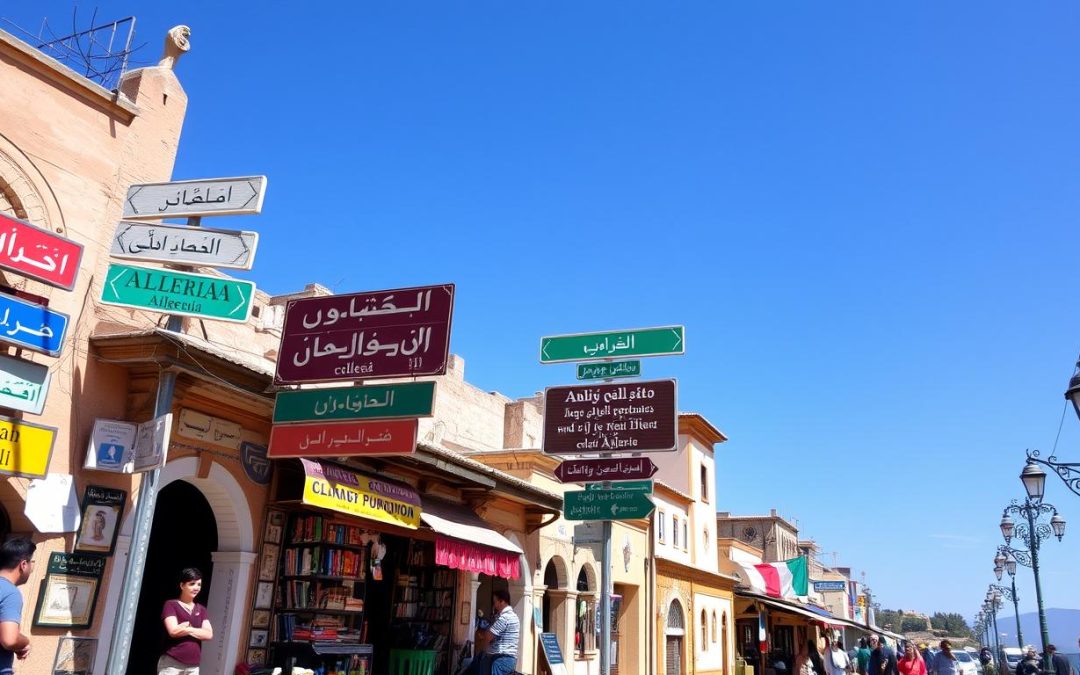Have you ever thought about how one country can have many languages? In Algeria, language diversity is not just a fact. It’s a deep part of the country’s identity, showing its rich history, strength, and cultural mix.
Algeria’s language scene is colorful, with Arabic, Berber, and French all playing a role. This mix shows the country’s long and complex history. It blends old traditions with the marks of colonial times.
About 81% of Algerians speak Arabic, and around 27% speak Berber languages. These languages are more than just ways to talk. They carry the country’s history, its fight for freedom, and its pride.
Key Takeaways
- Algeria officially recognizes Arabic and Berber as national languages
- Arabic became the official language in 1990
- Berber gained official status in 2016
- More than 99% of Algerians speak either Berber or Algerian Arabic
- French remains widely used in urban areas and professional settings
Historical Evolution of Languages in Algeria
Algeria’s language scene is a colorful mix of history and culture. To understand this, we must explore the complex language policies that have shaped the country’s way of speaking.
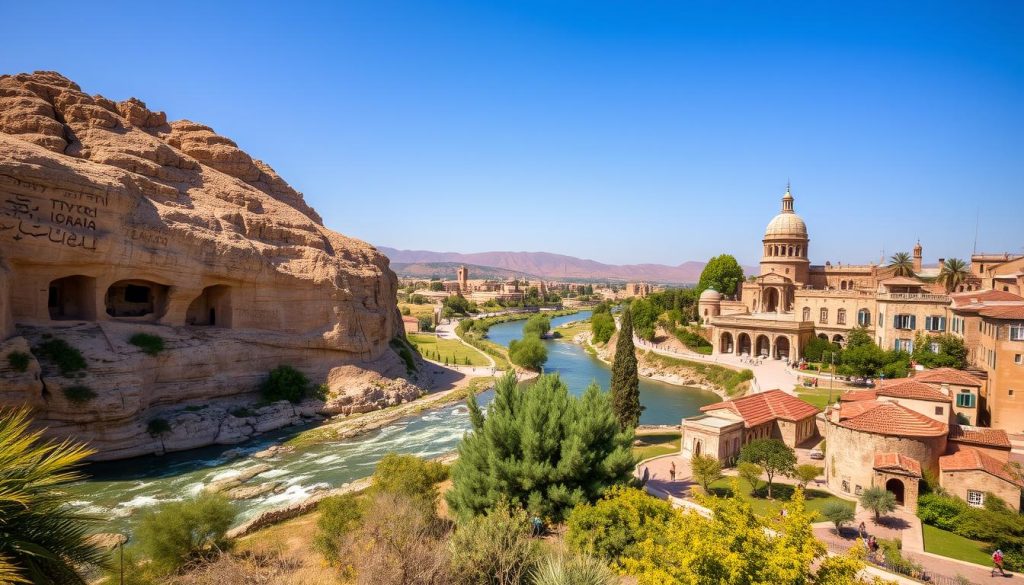
The story of Algeria’s languages spans many eras. Each era has left its mark on how people communicate:
Pre-Colonial Language Foundations
Before the French came, Algeria was mostly Berber-speaking. Tamazight was the main language, with roots going back thousands of years. Archaeology shows that Berber languages were widespread, surviving many invasions.
- Berber languages were the majority
- Even ancient times had language diversity
- People resisted changing their language
French Colonization’s Linguistic Impact
The French rule changed Algeria’s language scene a lot. French became key for government, schools, and getting ahead. This created a gap in language that lasted after Algeria became independent.
“Language is the road map of a culture. It tells you where its people come from and where they are going.” – Rita Mae Brown
Post-Independence Language Policies
After gaining freedom in 1962, Algeria started a new chapter in language policy. The government made Arabic the official language. This move was to reconnect with their culture and break free from French rule.
| Language | Official Status Year | Approximate Speakers |
|---|---|---|
| Arabic | 1963 | 72% of population |
| Tamazight | 2016 | 27.4% of population |
Today, Algeria is a great example of how languages can survive and thrive together. This shows the nation’s rich cultural heritage.
Modern Standard Arabic as the Primary Official Language
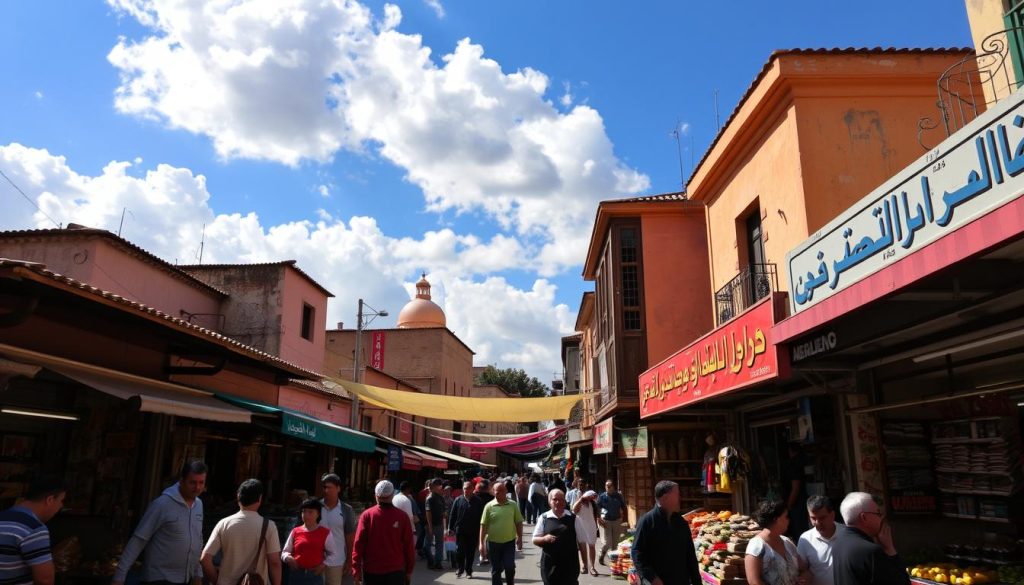
Modern Standard Arabic is key to Algeria’s identity and how people talk to each other. It’s the main language used in official talks, schools, and government. It’s the foundation of how the country communicates.
Exploring Arabic in Algeria shows a deep linguistic world. In 2008, about 72% of Algerians spoke Arabic. The way people use it varies a lot:
- 60% spoke Algerian Arabic dialect (Derja)
- 11.3% spoke Hassaniyya Arabic
- Smaller percentages used other Arabic variations
Modern Standard Arabic (MSA) is different from the Algerian Arabic dialect. While Derja is used in daily talks, MSA is for official documents, media, and schools.
“Arabic is not just a language, but a bridge connecting cultural identities across North Africa” – Contemporary Linguistic Scholars
MSA connects over 400 million people worldwide. In Algeria, it’s more than a language. It’s about national unity and keeping culture alive.
Learning about Algerian language shows how Modern Standard Arabic is more than talking. It’s a symbol of national heritage and shared culture.
Berber (Tamazight): The Second Official Language
Algeria has changed a lot by recognizing Berber languages as key to its culture. Tamazight’s journey from being ignored to an official language is a story of keeping culture alive and being proud of it.
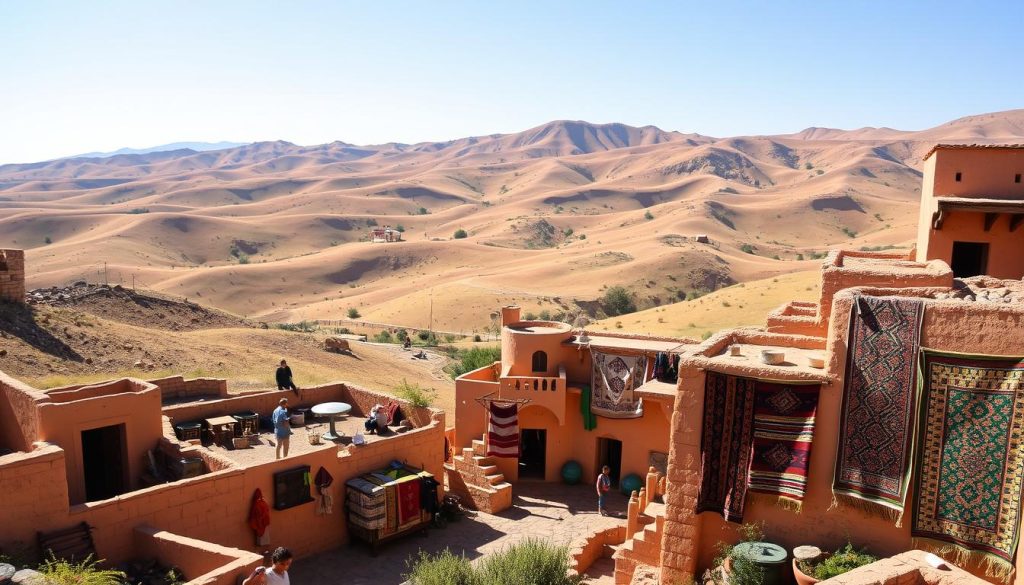
In 2016, Algeria made a big step by making Tamazight the second official language. This move recognized the rich history of Berber languages. It came after years of fight by the indigenous people to keep their language alive.
Constitutional Recognition and Significance
The recognition of Berber languages in the constitution is a big win for indigenous language rights. Almost half of Algeria’s people speak Tamazight, showing its deep cultural value.
Major Berber Dialects
Algeria has many important Berber language dialects, each with its own special traits:
- Kabyle language: Mostly spoken in Kabylia
- Chaoui language: Common in the Aurès Mountains
- Tuareg dialect: Spoken in the Algerian Sahara
Geographic Distribution of Berber Speakers
| Region | Primary Berber Dialect | Estimated Speakers |
|---|---|---|
| Kabylia | Kabyle | Approximately 3 million |
| Aurès Mountains | Chaoui | Around 1.5 million |
| Algerian Sahara | Tuareg | Approximately 500,000 |
Berber languages are a key link to Algeria’s indigenous culture. They are spoken in different parts of the country. Their official status helps keep this rich language tradition alive and celebrated.
“Language is the road map of a culture. It tells you where its people come from and where they are going.” – Rita Mae Brown
Algerian Arabic Dialect (Derja)
The Algerian Arabic dialect, known as Derja, is at the heart of daily talk for most Algerians. It has about 36 million native speakers and 5.7 million who use it as a second language. This dialect is used by nearly 75-80% of the population every day.
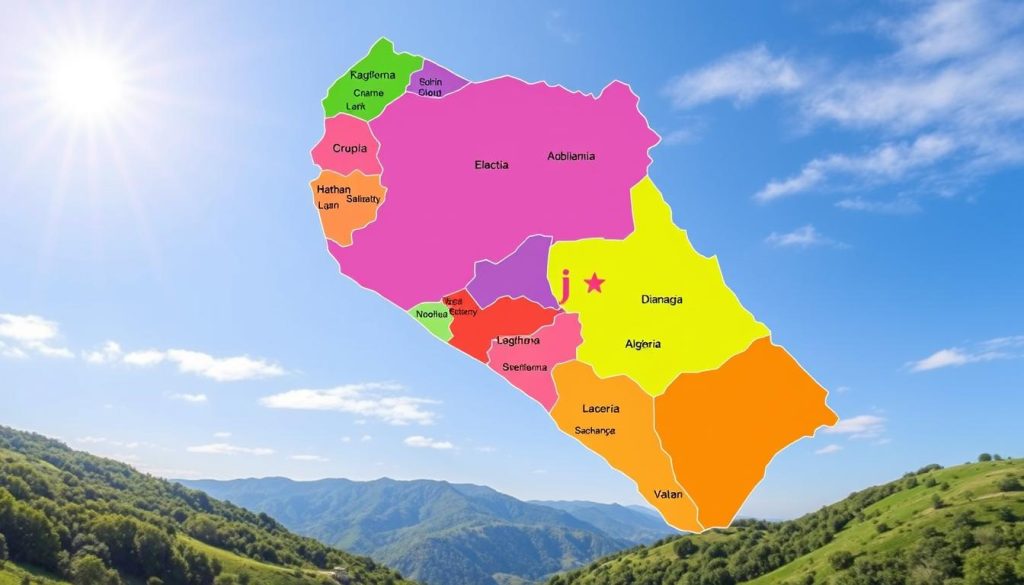
Derja is a special part of Algeria’s language mix. It’s different from Modern Standard Arabic because of its own unique traits:
- Simplified vowel system
- Significantly altered vocabulary
- Absence of classical Arabic case endings
- Rich linguistic blend of Berber, French, and Arabic influences
The dialect shows big differences in different areas. Cities like Algiers have their own koine languages. This shows how dynamic Algerian Arabic communication is.
“Derja is not just a language, it’s the soul of Algerian street conversation” – Algerian Linguistic Research Center
Research into Algerian Arabic dialect has uncovered interesting facts:
| Linguistic Feature | Characteristic |
|---|---|
| Berber Loanwords | 8-9% of vocabulary |
| Urban Communication | 90% use Derja predominantly |
| Bilingual Speakers | 20% speak Derja and French |
The dialect is always changing. The first novel in Algerian Arabic came out in 2021. This shows its growing importance. People living in cities especially use Derja a lot. It makes a rich language mix that shows off Algeria’s complex culture.
French Language Influence and Current Status
The French language has made a lasting impact on Algeria’s language scene. Even though it’s not an official language, French is still a big part of daily life and work. Algeria is the second biggest country where French is spoken, showing its rich history and cultural ties.
Role in Education and Administration
French is key in Algeria’s schools and government. Here are some interesting facts:
- By 2008, 11.2 million Algerians (33%) could read and write in French
- Nearly 18 million Algerians can read and understand French
- The language remains a standard part of the school curriculum
Usage in Media and Business
French is the main language in many areas of Algeria. Here’s what digital trends show:
- In 2014, 76% of Facebook users posted in French
- The French-language Wikipedia accounted for 45% of page views in 2016
- Business communications frequently utilize French as a primary language
French as a Lingua Franca
French is a key language for communication in Algeria, helping to connect different languages. Multilingualism in Algeria shows how French is widely understood and used. The language policy in Algeria still values French, even as Arabic and English become more popular.
“Language is the road map of a culture. It tells you where its people come from and where they are going.” – Rita Mae Brown
With nearly 15 million speakers, French is a strong language in Algeria. It shows the country’s ongoing cultural and communication growth.
Language Education and Literacy in Algeria
Algeria’s language policy has shaped its education system. It reflects the country’s rich linguistic heritage. This policy influences how students learn and communicate in different settings.
The national education system focuses on several key languages:
- Modern Standard Arabic as the main teaching language
- Berber (Tamazight) as a recognized national language
- French as a widely used secondary language
Literacy rates in Algeria have seen a big improvement. About 81.4% of the population can read and write. The education system aims to promote national identity and preserve culture through language.
“Language is the roadmap of a culture. It tells you where its people come from and where they are going.” – Rita Mae Brown
Students face a multilingual educational environment. Here’s how:
- Primary schools mainly teach in Modern Standard Arabic
- French is introduced as a mandatory second language
- Berber languages are increasingly part of the curriculum
There are challenges in balancing education with linguistic diversity. Recent reforms aim to make language learning more inclusive. This is to prepare students for their future.
The ongoing language evolution continues to shape Algeria’s educational and cultural landscape.
Regional Language Variations and Minority Languages
Algeria’s language scene is more than just its main languages. It’s a rich mix of local dialects and traditional languages. The country’s wide range of landscapes creates unique language areas that show off local cultures.
Saharan Arabic Dialects
The Sahara Desert, covering about 80 percent of Algeria, has its own Arabic dialects. These Saharan Arabic forms are more traditional. They are spoken by Bedouin groups.
- Hassaniya Arabic is mainly spoken by Sahrawi refugees in Tindouf
- Bedouin dialects keep traditional language traits
- These variations show complex cultural exchanges
Indigenous Language Diversity
Algeria also has many minority languages, adding to its linguistic wealth. The Tashelhiyt language is a key example. It keeps alive unique cultural expressions.
| Language Group | Region | Speakers |
|---|---|---|
| Tashelhiyt | Southern Regions | Limited Population |
| Mzab-Wargla | M’zab Valley | Specific Communities |
| Judeo-Arabic Dialects | Historical Jewish Communities | Diminishing Speakers |
These minority languages are more than just ways to talk. They are treasuries of cultural history and experiences in Algeria’s Arabic dialect world.
Language is the road map of a culture. It tells you where its people come from and where they are going. – Rita Mae Brown
Language Use in Media, Literature, and Popular Culture
Multilingualism in Algeria makes its culture vibrant and diverse. The Algerian Arabic dialect, or Derja, is key in shaping how people communicate. It blends with other languages in media, literature, and art.
“The language spoken at home and in the street remains a mixture of Algerian dialect and French words.” – Malika Rebai Maamri
Algeria’s media shows a rich mix of languages. This diversity is seen in many areas of culture:
- Television and radio programs broadcast in multiple languages
- Newspapers published in Arabic and French
- Online media reflecting linguistic complexity
Algerian writers are creative with language in their books. They mix Arabic, Berber, and French. This creates unique stories that show the nation’s rich language history.
| Media Platform | Primary Languages | Cultural Significance |
|---|---|---|
| Music | Rai, Chaabi | Reflects linguistic diversity |
| Cinema | Arabic, French | Over 175 film productions |
| Social Media | Derja, Arabic, French | Dynamic language interaction |
The music scene in Algeria is especially rich. Rai music is the most loved, while Chaabi is popular with the older crowd. The government supports this by hosting seven music festivals a year. These festivals celebrate local and regional music.
Conclusion: The Future of Languages in Algeria
Algeria’s language journey is complex and ever-changing. The country’s mix of Arabic, Berber, and French shows its rich culture. This blend shapes the nation’s identity.
The balance between keeping languages alive and moving forward is delicate. Arabic is spoken by about 81% of people, and Berber by 27%. In 2016, Tamazight became an official language, celebrating Algeria’s linguistic heritage.
Young people in Algeria are growing up with many languages. They learn traditional languages and modern communication skills. Schools are adapting to keep languages a source of pride and practical use.
Algeria’s language scene will keep changing, showing the country’s evolving society and culture. The mix of Arabic, Berber, and French will continue to highlight Algeria’s complex history and culture. This mix offers a unique view of national identity and how people communicate.
The above is subject to change.
Check back often to TRAVEL.COM for the latest travel tips and deals.
Here are some Tours & Sightseeing suggestions that might pique your interests!
